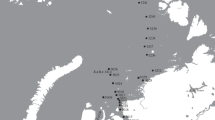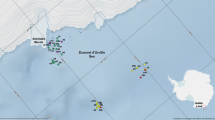Abstract
Universal classification schemes have been proposed for the vertical zonation of sessile benthos on intertidal rocky shores; however, generalized patterns among deep-sea meiofauna of different regions remain rare. We conducted a preliminary, family-level study of deep-sea harpacticoid diversity and community composition off Tosa Bay, Shikoku island, Japan, along a transect on a landward continental slope of the Nankai Trough. We then compared these data to those of other subduction zones along the Japanese island arc, including the Kuril, Japan, and Ryukyu trenches. Common bathymetric trends in harpacticoid composition were observed among these subduction zones from upper bathyal to abyssal depths (400–5800 m). Ectinosomatidae was the most abundant family within this depth interval; however, its frequency decreased with increasing depth, whereas the abundance of Pseudotachidiidae was highest at abyssal depths. Harpacticoid composition differed significantly between landward slopes of the Ryukyu Trench and those of the Japan and Kuril trenches. However, harpacticoid composition on the landward slope of the Nankai Trough, between the Ryukyu and Japan trenches, was similar to that around the neighboring subduction zones. These findings imply that patterns of deep-sea harpacticoid community composition are similar along the continental slope of the Japanese island arc, and that the Izu–Ogasawara arc, which subdivides the subduction zones, has not functioned as a physical barrier to harpacticoid expansion between zones.




Similar content being viewed by others
References
Ahnert A, Schriever G (2001) Response of abyssal Copepoda Harpacticoida (Crustacea) and other meiobenthos to an artificial disturbance and its bearing on future mining for polymetallic nodules. Deep-Sea Res II 48:3779–3794
Anderson MJ, Gorley RN, Clarke KR (2008) PERMANOVA+ for PRIMER: guide to software and statistical methods. Plymouth, PRIMER-E, p 214
Baguley JG, Montagna PA, Lee W, Hyde LJ, Rowe GT (2006) Spatial and bathymetric trends in Harpacticoida (Copepoda) community structure in the Northern Gulf of Mexico deep-sea. J Exp Mar Biol Ecol 330:327–341
Boxshall GA, Halsey SH (2004) An introduction to copepod diversity. Ray Society, London
Clarke KR, Warwick RM (2001) Change in marine communities: an approach to statistical analysis and interpretation, 2nd edn. Plymouth, PRIMER-E
Coull BC (1972) Species diversity and faunal affinities of meiobenthic Copepoda in the deep sea. Mar Biol 14:48–51
Danovaro R (2010) Methods for the study of deep-sea sediments, their functioning and biodiversity. CRC, London
Danovaro R, Gambi C, Lampadariou N, Tselepides A (2008) Deep-sea nematode biodiversity in the Mediterranean Basin: testing for longitudinal, bathymetric and energetic gradients. Ecography 31:231–244
Gambi C, Vanreusel A, Danovaro R (2003) Biodiversity of nematode assemblages from deep-sea sediments of the Atacama Slope and Trench (South Pacific Ocean). Deep-Sea Res I 50:103–117
George KH (2005) Sublittoral and bathyal Harpacticoida (Crustacea: Copepoda) of the Magellan region. Composition, distribution and species diversity of selected major taxa. Scientia Marina 69:147–159
George KH, Schminke HK (2002) Harpacticoida (Crustacea, Copepoda) of the Great Meteor Seamount, with first conclusions as to the origin of the plateau fauna. Mar Biol 144:887–895
George KH, Veit-Köhler G, Arbizu PM, Seifried S, Rose A, Willen E, Bröhldick K, Corgosinho PH, Drewes J, Menzel L, Moura G, Schminke HK (2014) Community structure and species diversity of Harpacticoida (Crustacea: Copepoda) at two sites in the deep sea of the Angola Basin (Southeast Atlantic). Org Divers Evol 14:57–73
George KH, Pointner K, Packmor J (2018) The benthic Copepoda (Crustacea) of Anaximenes Seamount (eastern Mediterranean Sea)—community structure and species distribution. Prog Oceanogr 165:299–316
Gheerardyn H, Veit-Köhler G (2009) Diversity and large-scale biogeography of Paramesochridae (Copepoda, Harpacticoida) in South Atlantic Abyssal Plains and the deep Southern Ocean. Deep-Sea Res I 56:1804–1815
Giere O (2009) Meiobenthology, 2nd edn. Springer, Hamburg
Gregg WW, Conkright ME, Ginoux P, O’Reilly JE, Casey MW (2003) Ocean primary production and climate: global decadal changes. Geophys Res Lett. https://doi.org/10.1029/2003gl016889
Hicks GRF, Coull BC (1983) The ecology of marine meiobenthic harpacticoid copepods. Oceanogr mar Biol ann Rev 21:67–175
Huys R, Gee JM, Moore CG, Hamond R (1996) Marine and brackish water harpacticoid copepods, part 1. Field Studies Council, Shrewsbury, p 352
Itoh M, Kawamura K, Kitahashi T, Kojima S, Katagiri H, Shimanaga M (2011) Bathymetric patterns of meiofaunal abundance and biomass associated with the Kuril and Ryukyu trenches, western North Pacific Ocean. Deep-Sea Res I 58:86–97
Jamieson A (2015) The hadal zone: life in the deepest oceans. Cambridge University Press, Cambridge, p 372
Jumars PA, Hessler RR (1976) Hadal community structure: implications from the Aleutian Trench. J Mar Res 34:547–560
Kakinoki K, Imawaki S, Ichikawa K, Umatani S, Kashima M (2008) Variations of velocity and transport associated with coastal cyclonic eddies off Shikoku, Japan estimated from moored current meter and IES data. Reports of research institute for Applied Mechanics, Kyushu University 135:53–59. (in Japanese with English abstract)
Khodami S, McArthur JV, Blanco-Bercial L, Martinez Arbizu P (2017) Molecular phylogeny and revision of Copepod orders (Crustacea: Copepoda). Sci Rep 7:9164. https://doi.org/10.1038/s41598-017-06656-4
Kitahashi T, Kawamura K, Veit-Köhler G, Danovaro R, Tietjen J, Kojima S, Shimanaga M (2012) Assemblages of Harpacticoida (Crustacea: Copepoda) from the Ryukyu and Kuril trenches, north–west Pacific Ocean. J Mar Biol Ass UK 92:275–286
Kitahashi T, Kawamura K, Kojima S, Shimanaga M (2013) Assemblages gradually change from bathyal to hadal depth: a case study on harpacticoid copepods around the Kuril Trench (north–west Pacific Ocean). Deep-Sea Res I 74:39–47. https://doi.org/10.1016/j.dsr.2012.12.010
Kitahashi T, Jenkins RG, Nomaki H, Shimanaga M, Fujikura K, Kojima S (2014a) Effect of the 2011 Tohoku earthquake on deep-sea meiofaunal assemblages inhabiting the landward slope of the Japan trench. Mar Geol 358:128–137
Kitahashi T, Kawamura K, Kojima S, Shimanaga M (2014b) Bathymetric patterns of α and β diversity of harpacticoid copepods at the genus level around the Ryukyu Trench, and turnover diversity between trenches around Japan. Prog Oceanogr 123:54–63. https://doi.org/10.1016/j.pocean.2014.02.007
Kitahashi T, Watanabe H, Ikehara K, Jenkins RG, Kojima S, Shimanaga M (2016) Deep-sea meiofauna off the Pacific coast of Tohoku and other Trench slopes around Japan: a comparative study before and after the 2011 off the Pacific coast of Tohoku earthquake. J Oceanogr 72:129–139
Kitahashi T, Jenkins RG, Kojima S, Shimanaga M (2018) High resilience of harpacticoid copepods in the landward slope of the Japan Trench against disturbance of the 2011 Tohoku earthquake. Limnol Oceanogr. https://doi.org/10.1002/lno.11006
Leduc D, Rowden AA (2018) Nematode communities in sediments of the Kermadec trench, Southwest Pacific Ocean. Deep-Sea Res I 134:23–31. https://doi.org/10.1016/j.dsr.2018.03.003
Leduc D, Rowden AA, Probert PK, Pilditch CA, Nodder SD, Vanreusel A, Duineveld GCA, Witbaard R (2012) Further evidence for the effect of particle-size diversity on deep-sea benthic biodiversity. Deep-Sea Res I 63:164–169. https://doi.org/10.1016/j.dsr.2011
Magurran AE (1988) Ecological diversity and its measurement. Chapman and Hall, London
Menzel L, George KH (2012) Copepodid and adult Argestidae Por, 1986 (Copepoda: Harpacticoida) in the southeastern Atlantic deep sea: diversity and community structure at the species level. Mar Biol 159:1223–1238
Menzel L, George KH, Martínez Arbizu P (2011) Submarine ridges do not prevent large-scale dispersal of abyssal fauna: a case study of Mesocletodes (Crustacea, Copepoda, Harpacticoida). Deep-Sea Res I 58:839–864
Min WG, Kim D, Rho HS, Chi SB, Son SK (2018) Distribution and variability of the meiobenthic assemblages near the Korean polymetallic nodule claim area of the Clarion-Clipperton Fracture zone (subequatorial NE Pacific). Ocean Sci J 53:315–336
Montagna P (1982) Morphological adaptation in the deep-sea benthic harpacticoid copepod family Cerviniidae. Crustaceana 42:37–43
Qiu B (2001) Kuroshio and Oyashio currents. In: Steele J, Thorpe S, Turekian K (eds) Encyclopedia of ocean sciences. Academic, New York, pp 1413–1425
Raffaelli D, Hawkins S (1999) Intertidal ecology, 2nd edn. Kluwer, Netherlands
Rex MA, Etter RJ (2010) Deep-sea biodiversity: pattern and scale, 1st edn. Harvard University Press, Cambridge
Rosli N, Leduc D, Rowden AA, Probert PK (2018) Review of recent trends in ecological studies of deep-sea meiofauna, with focus on patterns and processes at small to regional spatial scales. Mar Biodiv 48:13–34. https://doi.org/10.1007/s12526-017-0801-5
Schmidt C, Lins L, Brandt A (2018) Harpacticoida (Crustacea, Copepoda) across a longitudinal transect of the Vema Fracture zone and along a depth gradient in the Puerto Rico trench. Deep-Sea Res II 148:236–250
Schmidt C, Sattarova VV, Katrynski L, Martínez Arbizu P (2019) New insights from the deep: meiofauna in the Kuril–Kamchatka Trench and adjacent abyssal plain. Prog Oceanogr 173:192–207
Seifried S (2004) The importance of a phylogenetic system for the study of deep-sea harpacticoid diversity. Zool Stud 43:8–19
Shimanaga M, Kitazato H, Shirayama Y (2004) Temporal patterns in diversity and species composition of deep-sea benthic copepods in bathyal Sagami Bay, central Japan. Mar Biol 144:1097–1110
Shirayama Y (1984) The abundance of deep sea meiobenthos in the Western Pacific in relation to environmental factors. Oceanol Acta 7:113–121
Takahashi M, Saito K (1997) Miocene intra-arc bending at an arc-arc collision zone, central Japan. Island Arc 6:168–182
Thistle D, Sedlacek L, Carman KR, Fleeger JW, Barry JP (2007) Emergence in the deep sea: evidence from harpacticoid copepods. Deep Sea Res I 54:1008–1014
Thistle D, Sedlacek L, Carman KR, Barry JP (2017) Influence of habitat heterogeneity on the community structure of deep-sea harpacticoid communities from a canyon and an escarpment site on the continental rise off California. Deep Sea Res I 123:56–61. https://doi.org/10.1016/j.dsr.2017.03.005
Tietjen JH (1989) Ecology of deep-sea nematodes from the Puerto Rico Trench area and Hatteras Plain. Deep-Sea Res 36:1579–1594
Vanhove S, Vermeeren H, Vanreusel A (2004) Meiofauna towards the South Sandwich Trench (750–6300 m), focus on nematodes. Deep-Sea Res II 51:1665–1687
Vincx M, Bett BJ, Dinet A, Ferrero T, Gooday AJ, Lambshead PJD, Pfannkuche O, Soltwedel T, Vanreusel A (1994) Meiobenthos of the deep northeast Atlantic. Adv Mar Biol 30:1–87
Walter TC, Boxshall G (2018) World of Copepods Database. http://www.marinespecies.org/copepoda. Accessed Feb 20, 2019
Watling L, Guinotte J, Clark MR, Smith CR (2013) A proposed biogeography of the deep ocean floor. Prog Oceanogr 111:91–112
Wells JBJ (2007) An annotated checklist and keys to the species of Copepoda Harpacticoida (Crustacea). Magnolia, Aukland
Yasuhara M, Hunt G, Cronin TM, Hokanishi N, Kawahata H, Tsujimoto A, Ishitake M (2012) Climatic forcing of quaternary deep-sea benthic communities in the North Pacific Ocean. Paleobiology 38:162–179
Zar JH (1999) Biostatistical analysis, 4th edn. Englewood Cliffs, Prentice-Hall
Zeppilli D, Leduc D, Fontanier C, Fontaneto D et al (2018) Characteristics of meiofauna in extreme marine ecosystems: a review. Mar Biodivers 48:35–71
Acknowledgements
The authors are grateful to the officers and crew of the research vessel Hakuho Maru and to the Japan Agency for Marine–Earth Science and Technology (JAMSTEC). Comments by two anonymous reviewers greatly improved our manuscript. This study was partly funded by a grant from the Japan Society for the Promotion of Science Grants-in-Aid for Scientific Research (KAKENHI) program (Grant number 22770022).
Author information
Authors and Affiliations
Corresponding author
Electronic supplementary material
Below is the link to the electronic supplementary material.
Rights and permissions
About this article
Cite this article
Shimanaga, M., Kitahashi, T. & Kawamura, K. First insight of bathymetric patterns among deep-sea harpacticoid diversity and composition on landward slopes of subduction zones along the Japanese island arc. J Oceanogr 75, 475–484 (2019). https://doi.org/10.1007/s10872-019-00516-7
Received:
Revised:
Accepted:
Published:
Issue Date:
DOI: https://doi.org/10.1007/s10872-019-00516-7




